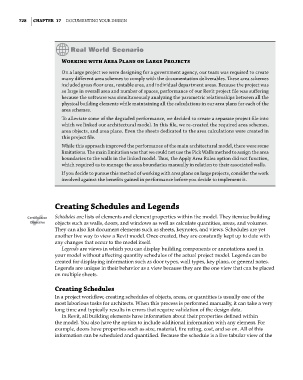Page 762 - Divyank Tyagi
P. 762
728 | ChaPteR 17 Documenting Your Design
Working with area Plans on Large Projects
on a large project we were designing for a government agency, our team was required to create
many different area schemes to comply with the documentation deliverables. These area schemes
included gross floor area, rentable area, and individual department areas. Because the project was
so large in overall area and number of spaces, performance of our revit project file was suffering
because the software was simultaneously analyzing the parametric relationships between all the
physical building elements while maintaining all the calculations in our area plans for each of the
area schemes.
to alleviate some of the degraded performance, we decided to create a separate project file into
which we linked our architectural model. in this file, we re-created the required area schemes,
area objects, and area plans. even the sheets dedicated to the area calculations were created in
this project file.
While this approach improved the performance of the main architectural model, there were some
limitations. The main limitation was that we could not use the Pick Walls method to assign the area
boundaries to the walls in the linked model. Thus, the apply area rules option did not function,
which required us to manage the area boundaries manually in relation to their associated walls.
if you decide to pursue this method of working with area plans on large projects, consider the work
involved against the benefits gained in performance before you decide to implement it.
Creating Schedules and Legends
Certification Schedules are lists of elements and element properties within the model. They itemize building
Objective objects such as walls, doors, and windows as well as calculate quantities, areas, and volumes.
They can also list document elements such as sheets, keynotes, and views. Schedules are yet
another live way to view a Revit model. Once created, they are constantly kept up to date with
any changes that occur to the model itself.
Legends are views in which you can display building components or annotations used in
your model without affecting quantity schedules of the actual project model. Legends can be
created for displaying information such as door types, wall types, key plans, or general notes.
Legends are unique in their behavior as a view because they are the one view that can be placed
on multiple sheets.
Creating Schedules
In a project workflow, creating schedules of objects, areas, or quantities is usually one of the
most laborious tasks for architects. When this process is performed manually, it can take a very
long time and typically results in errors that require validation of the design data.
In Revit, all building elements have information about their properties defined within
the model. You also have the option to include additional information with any element. For
example, doors have properties such as size, material, fire rating, cost, and so on. All of this
information can be scheduled and quantified. Because the schedule is a live tabular view of the
c17.indd 728 5/3/2014 11:46:25 AM

